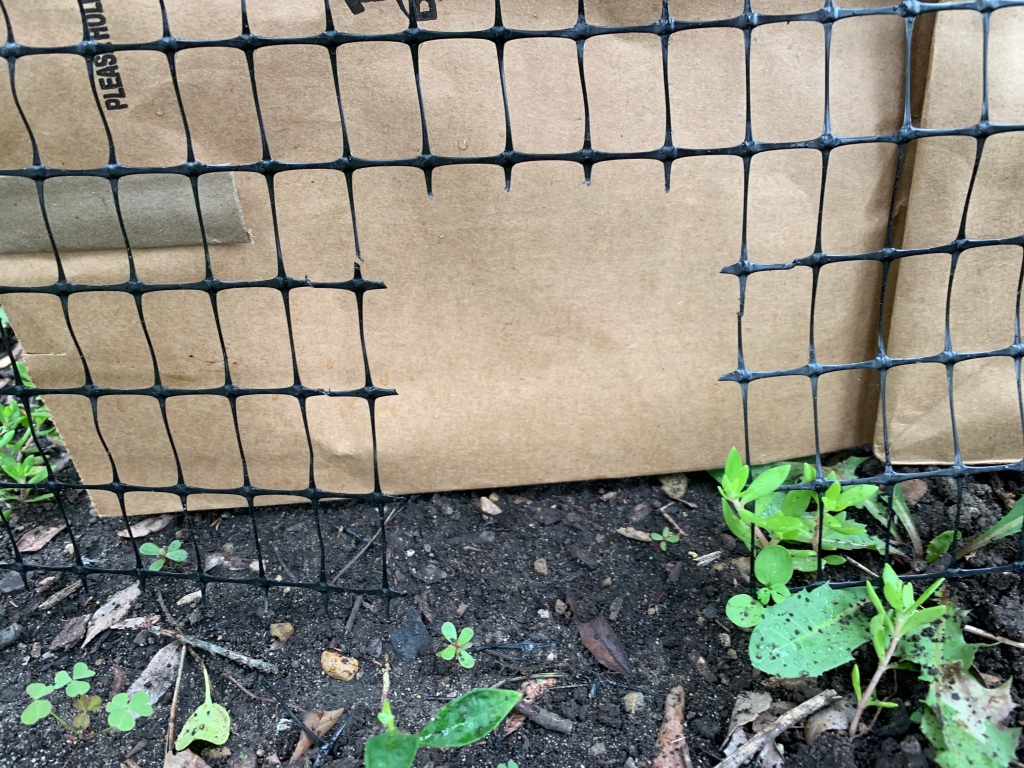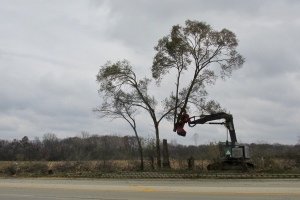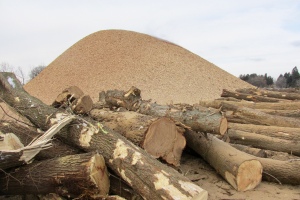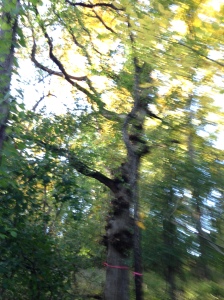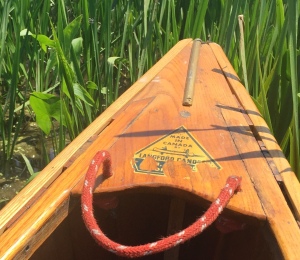For the past couple of weeks I have been enchanted by a Facebook site whose entire focus is looking back at my old hometown, Delhi Ontario.

Young fishers on the bank, waiting hopefully for that first tug.
It has been a treat, viewing grade school pictures and tagging names to people I haven’t seen in 60 years. There have been renewed conversations with these long lost friends. While the site’s members are asking others to remember their shared experiences, it has also rekindled some memories of my own that I clearly had forgotten. Running central through these experiences is Big Creek.

The creek drains west Norfolk, like a vast willowy exotic plant.
Big Creek is about 40 miles long from its smallest tributary running into Windham township, at the northern border of Norfolk County. As it heads south towards Lake Erie it gains volume and girth, first with the addition of Brondy Creek north of town, then Cranberry Creek, from the west, in Middleton, then Trout Creek and Silver Creek come from the east, in Charlotteville. Further south it expands as Venison Creek flows in from the west of Walsingham.

Two youngsters head into the edge of the Carolynian forest.
It drains west Norfolk through a valleyed web of locally named brooks, streams, rivulets, freshets and runs that on a map looks like the willowy profile of a vast, exotic plant. Through its valleys grow a robust Carolinian forest, distinguished by towering beech, hickory, walnut, sassafras, butternut and tulip trees. The woods are alive with rich scents and sounds, modified by the steady gurgle of flowing water. Underfoot we find marsh marigolds and vast spreads of skunk cabbage.
Along every bank there is a path, both sides, worn deep by the feet of literally centuries of generations of natives, settlers, small animals and small people. They are there to walk, fish, camp, trap, hunt, swim, wade and stare deep into the current’s constant pushing of sand and silt towards the lake.

Green pools hide the fish on a sunny afternoon.
Fighting the flow are small fish– trout: brook, brown, and occasional suckers which vacuum the river bed. They are scurrying against the riffles to sink deep into the green pools under fallen trees and trapped logs. Every elbow in the river is the occasional site of fishers dangling a monofilament line over the pool, waiting for a tug.

The creek offered new events at every turn, especially after the spring floods.
As a boy, no more than 8 or 9, I accepted the waterway as open territory for discovery, as did all of my friends. Big Creek was as accessible as the school yard and main street. But more inviting, as it constantly delivered new events at every turn.
At the north end of town, a half mile pedal, racing down swimming pool road, a driveway took us into Deerlick, a rustic retreat. Some church owned it, and sent their meditating members off to think, and maybe relax. We wheeled in there on our bikes, and stopping in the woods, a few hundred yards, dumped our clothes, and jumped into a clear, shallow stream that flowed into the mother creek.
Icy water, 12 inches deep! We hung in long enough to claim a short rebellion against our parents’ warnings to stay out of trouble. Somewhere back towards the road we could hear the occasional rumble of cars over a steel bailey bridge paved with heavy, loose, oak timbers, and a pounding reminder that civilization wasn’t too far off.

The old swimming hole: fun, sand and noisy with shouts and splashes at a bend in the creek.
The little stream poured into a larger current, and a few minutes back to Delhi, past the horseshoe, which was an abandoned oxbow in the creek, and one could see the old swimming hole. A sturdy wire bridge was suspended over the creek to reach the other side.
This was a service club’s effort to offer some fun for the youth of Delhi. At a gentle bend in the creek, the water deepens as it wraps around a sandy beach, grossly out of place in the woods. Were it not for Norfolk’s sandy composition, there would be no beach. Nevertheless, there is a place to suntan, a change house, and every weekend the screams and chatters of a host of jubilant kids spread across the creek waters as they drift slowly by.

The dark water streamed by keeping us cool and moving.
The swimming hole is just that. Shallow on the beach side, the creek bed drops off immediately into a dark, murky green pool. The big kids jump off a diving board into the dark waters. On the beach side, I walk out to the end of a small dock and jump in, expecting to hit bottom, waist deep. There is no bottom, to my surprise, and am shocked enough to inhale two lungs full of water. My last memory is a stream of yellow bubbles rising before my eyes.
I woke up in the change house some time later. Luckily, I had been missed by a lifeguard who jumped in and pulled me out. She must have been terrified as they pumped me and shook me in the change house. I awoke under the eyes of a group of concerned kids. I had a horrific case of the hiccups which lasted all the way home as my brother escorted me. When I met my parents, I said I had taken a mouthful. A couple years ago, I sent that lifeguard a note with a picture of my family and grand kids. I pointed out they were her doing, and thanks.
The site was eventually downgraded to a camp for out-of-work transient tobacco workers, and the service club built a new pool up by the rink. Today the area is entirely unrecognizable, and the bridge is gone.

Skunk cabbage: big, voluptuous and odiferous.
The creek flows south, just behind a cliff. At the top is Talbot Street, and that is the address of the Anglican church, St. Albans, then St Casimir’s the Lithuanian church, and St John Brebuf school. It is one of the oldest streets in town, and is named after John Talbot who mapped southwestern Ontario, earning himself a throughway called the Talbot Road. More currently it is Highway 3.

Highway 3 bridge on the west side. Upstream we played hockey in the winter.
Just before Big Creek curves under the bridge, there is a slow spot. In the winter the ice forms easily, and we often went down to play hockey on the grey skin of ice in the winters. One had to be careful as open water drifted close by, and our mutual responsibility was to stop the puck from sliding into the icy black that bubbled and melted the edges of our rink.
After the bridge, the creek has a run of a couple hundred yards in shallow waters before it hits Quances Dam. There are stacks of rough cut wood there, six feet high, air-curing. I have climbed on those boards and waited for hours to spot the groundhogs coming out on a spring day to catch some noon sun. The brownie camera I hold takes vague, grey pictures, but they are gold to me, better than Disney, actually.
Big Creek jams up at the dam. The dam is old, originally placed there in 1830, and powered the lumber mill and feed mill owned by the Quances, one of Delhi’s earlier families.

Quance’s Dam: a concrete pillbox was our watching station for fish jumping.
In my younger years there, I never sensed that lumber was a business. The dam was for our entertainment entirely. Water cascaded over the concrete, separated by a ten-foot-high pill box between two spillways. We would jump into the pillbox to stare up into the lip of the dam that was under a steel bailey bridge. We looked for whatever was coming down, and occasionally for some hardy fish that thought they could jump up into the water above.

Quance’s Mill, creekside.
In the pool below there were small retention ponds built out of stones put there by fishers who wanted to keep their catch alive but captive, until they went home. One day we played in the pond looking for crayfish and found a nest of lamprey eel. They were just babies, about six inches long, flashing silver in our hands as we grabbed for them. They would grow eventually to attach themselves to the game fish in the stream, and in Lake Erie. Evil little slitherers.
Around the corner, there once was a hanging bridge that crossed the creek. I never saw it, but it was a convenience for folks who didn’t want to walk around Western Avenue to get to the dam, which was a rendezvous for many purposes. Farther down, the creek flows under the road, and past Stapleton’s stone welding and metal fabricating shop that is a landmark. When we built a go-kart, he built us an axle for the wheels.

Perhaps the loneliest, most foreboding building in town, our sewage plant.
Further south, the pungent odor of sulphur fouls the air. We have frequently walked down the dirt road to the town’s sewage plant. There, we would pass by a one-story cinder block building, lonely, unattractive and foreboding. Beside it, a fenced off water distribution system carouseled around a 60-foot-wide circle, dripping treated water into a bed of rocks. There was an intrepid group of truants who climbed the fence and rode the pipes one afternoon, reportedly. There was mention of a police visit. It was during school hours, so we missed that. Nevertheless, we were in awe of their bravado.
Beside the sewage plant springs a bubbling fountain of sulphur water. It boils out of the ground, exuding its trademark stench, and leaves a milky film over the rocks as it flows down to the creek. Like a saviour, Big Creek takes both the sulphur water and the treated sewage water away, cleansing the town of its trespasses.
A couple more bends in the creek and it curves past a reforested pine woods. There were many Saturdays when we sat in those woods, loaded up with a giant bottle of Coca Cola and a pack of cigarettes and solved the problems of our world, mostly school, teachers, parents and girls. The meandering creek took our troubles away with it.

The new Lehman’s Dam, equipped with fish ladder forms a magnificent small lake extending to highway 3.
Just before it hits another bridge, the waters are joined by the North branch as it is called locally, and Lehman’s dam traps a small lake of water further upstream. If one ventures up North creek, it eventually cuts under highway 3. Just around the corner we camped up there for a night in a small canvas wall tent. Fire, food, smokes, our friendly companion dog for company, and the calls of mourning doves made for a pleasant vacation in the woods. We were 11 years old, and living the good life.

The early Grand Trunk steam engines blew their whistle on the trestle coming into town.
Back down at Big Creek proper, it travels south under the railway trestle. Grand Trunk used to run trains over it, and then the CNR. The trestle still stands today, black and rusted, out of use, and it is a monument to the energy and will of a bygone business generation. 50-year-old trees are growing among its foundations. When I was very young that same rail line had steam engines pounding over the rails, and I can remember their flute-like whistles, nothing like today’s diesels with their air horns.

The trestle today, unused but picturesque. Credit: Randy Goudeseune.
This patch of creek is a highway for foot traffic. We often came here, walking down from William street, over the tracks, and into the woods. On any given Saturday this was a destination hike, punctuated by a campfire, and a sizzling frying pan of hamburger, potatoes and onions.
There was a particular elbow that we would camp on, where the creek rushed by in six inches of rapids. Wandering out into the water, I fetched a peculiar rock that stuck out among the froth. Picking it up, it looked like a brick, but very smooth and scarred with shallow scallops like someone had scraped the sides with a spoon. It was block of flint.
Not knowing this, but still intrigued, I hefted the brick into my knapsack and took it home. There, I chipped away at it with my dad’s hammer, and amid the sparks, broke off sharp thin wafers of flint. Before long, I was failing, but enjoying the attempts at making flint arrowheads. Just another gift from the creek. I still have the rock today.

Dicks Hill bridge under horse and carriage.
On Saturdays we went for bike rides beyond the tobacco factory. The gravel road led to the long sloping Dick’s Hill intersected again by Big Creek. The steel bridge there was a bailey construction with rumbling timbers that shook with every car that crossed over. From that bridge you could fish, spit, drop stones and apples to the smoothly passing water below. The town council closed that bridge in the 70s, and cut off the neighbours to the west of the creek.

The bridge in 1984.
A couple hundred yards in, at another elbow we camped in a grassy clearing over a 24th of May weekend: wall tent, food, fire and our same faithful dog. It was a delicious, sunny warm afternoon followed by a quiet star-lit night. Totally inspired, we rigged up a large tripod, and boiled a 5-gallon drum full of water and took showers, then turned in to bed, wet heads on a mattress of pine bows. The dog wouldn’t enter the tent and slept outside, no doubt looking for varmints. Next morning we woke under a heavy chill, with horrendous, thick, throaty coughs. Outside, the dog slept, covered in a heavy coat of frost.

Croton Dam generated 60-cycle hydro to Quance’s Mill. It couldn’t hold the water back in 1937.
A couple miles down from Dicks Hill are the remains of Croton Dam. We got there by gravel road and bike. This structure was built over 50 years earlier in 1907, and blew out in 1937. By the time we discovered Croton it had a young forest of trees growing out of its foundations. The portions of the dam still standing are worthy of climbing and walking, all the time staring up the steep hill on the other side of the creek. Looking upstream, it’s easy, and stunning to visualize what the mill pond used to look like, stretching back perhaps half a mile. Croton provided Quances Mill with 60 cycle hydro, long before Ontario Hydro.
Our furthest bike pursuit of Big Creek was Lynedoch. This little hamlet is poised in a valley around the bridge over the creek. Just south is an orderly grove of walnut trees planted decades before: probably thirty or forty 50-foot trees in neat rows across the flats.
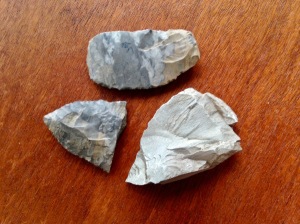
A few tools from the fields south of Lynedoch.
As the creek wanders past Lynedoch to another elbow, you can still walk up to the field above where there are arrow heads and tools left behind by an Indian village centuries ago. Just another find by the water’s edge if you care to look.
Having unloaded my memories of Big Creek, it comes to mind just how lucky we were as kids to live in an unfettered, free-range world, to wander for miles, away from home. By today’s urban standards, our parents would all be in court facing child abandonment charges. Thanks to their trust, and maybe to their post-war sense of relief, we were launched optimistically to explore and learn, full time.
All the while, Big Creek was our playground and classroom.
Thanks for hanging in there and getting this far. This was a long essay, but so is the creek. Please like and share this one! Thanks also to John Waite, Randy Goudeseune , James Bertling, and Alice DeGeyter whose Facebook posts supplied some of the images.



